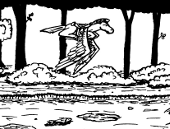4e Character Optimization Basics
By Cedric on March 28th, 2009Posted In: Blog,Gamer News,RPG News and Discussion
What is character optimization? Character Optimization is configuring the mechanical elements of a character build in accordance to the rules (both system rules and self-imposed ones), so that your character can best perform its given role. Some people use the term min/maxing to refer to the same activity, but some view that as having derogatory connotations so I try to avoid it.
A big misconception that many people have is that character optimization is the antithesis of role playing. They are related, but they are not two ends of a spectrum, with optimization at one end and role playing at another. Rather they represent the two separate axes of a graph where people can place their characters based on their own play styles. You can be a good optimizer and still be an excellent role player. Likewise, someone with a bad character build doesn’t necessarily make them a good role player (among online message boards, this is often referred to as the Stormwind Fallacy). If anything, in my personal experience, a bad build usually means the player hasn’t spent the time to learn the rules system or invested much in the character at all, so is likely to be equally bad at role playing that character.
A player can constrain a character with self-imposed limitations based on role playing decisions as a priority and there’s absolutely nothing wrong with that. However, there’s also nothing wrong with coming up with a build first and creating your character background to fit around that build. Both character creation processes are equally valid and after having seen hundreds of characters in actual play at a table, there is no noticeable difference.
I would just like to point out however that combat is an assumed and integral part of Dungeons and Dragons. Ignoring the combat worthiness of your character is not recommended if you’re going to be playing with strangers at a convention. If you’re playing only with your friends in a home game setting, then your party and DM can tailor the adventure to make up for your character’s short comings in combat. However, I personally rarely have fun playing weak characters that are ineffectual in D&D. If I wanted to play that type of game, then I would switch to playing Cthulu (where you are more likely to end up insane or dead than succeed the adventure) or some other system.
If you have an odd character (albino drow barbarian, with a fear of magic, sharp objects and dark places for example), then you should strive to at least give equal consideration to the combat worthiness of the build and strive to be as good as average in your given role. If your character was built with the stats and mechanics first, then make sure to come up with at least one outstanding character trait not based on your stats that is easily identifiable and can set your character apart from similar builds (if you’re playing yet another Tempus crit paladin or cleric for example, make sure you come up with more than just “the character worship Tempus”).
Those interested in more Character Optimization discussion should check back on this site for more segments on this topic.
You can also follow various Character Optimization discussions on the WotC forums.







Hey there. I found your site through a post you did on the penny arcade forums. Nice comic.
That comment about “being at least as good as average” is interesting. I know what you mean though. I played at a table one time with a guy playing a diplomat type. Not only did he suck in fights because all his feats were in something like profession (heraldry), but he actually tried to leave the area of fights because fighting was “beneath him”. Role playing shouldn’t be an excuse to be a bad team player.
Yeah. The worst case I could think of was a guy who roleplayed an obnoxious thief, tried to steal from the party, liked to start fights, and then just hid during combats, contributing nothing. It’s a team game people!
Great article Cedric. Two follow-up issues within this topic follow.
1. Players do not seem to coordinate well with controllers, except for very basic tactics like area attacks for minion groups. They don’t seem to utilize walls and forced movement well. Defender, striker, leader are fairly well defined roles. Controllers are rarely played to their fullest, IMO.
2. Players tend to build and play their characters for the first 3 rounds of combat and have trouble adjusting their tactics when battles prove hard. Even when it is clear that a monster has high defenses, leaders and controllers stay back, depriving much needed flank/combat advantage opportunities. Many characters squirrel gold away never investing in healing potions or resist potions assuming that healing will always be ample. Many also build “glass cannons” that parties have to sacrifice to prevent a total party kill.